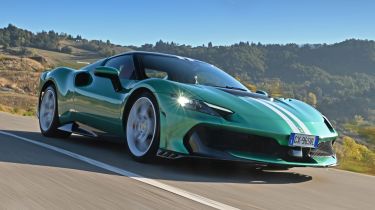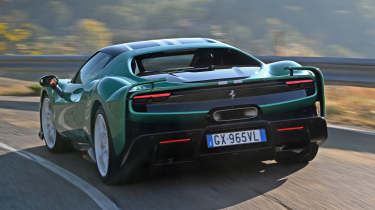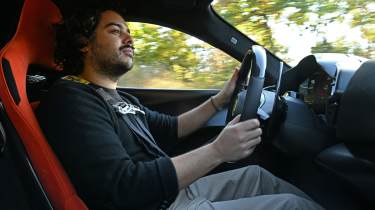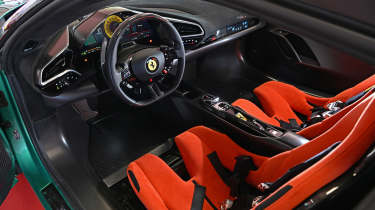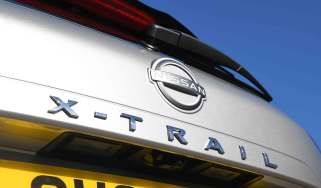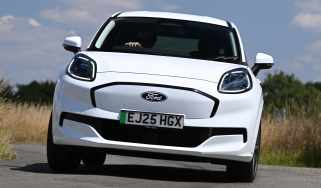Ferrari 296 Speciale review: a benchmark for modern supercars
The Ferrari 296 Speciale is simply a sensational supercar, with more performance than you could ever need

Verdict
Compared with the 296 GTB on which it’s based, the Ferrari 296 Speciale is more expensive, doesn’t have a huge amount more power and is less aesthetically pure. But to think the Speciale is anything less than a sensation would be a mistake, because it truly feels like the high-water mark for modern supercars. Performance is off the scale, yet it’s not intimidating – it feels with you every step of the way.
There’s always a sense of trepidation when you approach a ‘hardcore’ supercar, especially one with a prancing horse on its front wing. These cars take no prisoners. They’re intense, uncompromising, and often intimidating – whether that be on account of their performance, visibility or sheer expense. But when I slip behind the wheel of the new Ferrari 296 Speciale, this isn’t the overwhelming impression.
On paper the Speciale has an intense set of stats. Power generated from the hybrid-assisted powertrain has been uprated to 867bhp, derived from a 3.0-litre V6 engine with twin-turbochargers combined with an electric motor sandwiched between it and an eight-speed dual-clutch transmission. The e-motor itself can produce 178bhp, 13bhp more than before, and it’s fed by a 7.45kWh battery pack mounted behind the driver’s seat. Power is sent exclusively to the rear wheels.
Used - available now

2024 Volkswagen
T-Roc
9,100 milesManualPetrol1.0L
Cash £18,550
2024 Volkswagen
Tiguan AllSpace
25,250 milesAutomaticPetrol1.5L
Cash £23,050
2022 Volkswagen
ID.4
42,008 milesAutomaticElectric
Cash £15,600
2024 Volkswagen
Passat
24,388 milesAutomaticPetrol1.5L
Cash £19,200In total this peak figure is 38bhp more than the GTB, and has been liberated through a comprehensive set of new components inside the engine. Torque is 755Nm, but here’s the really impressive bit: the car’s overall weight has been cut by 60kg to a dry weight of 1,410kg.
This gives the 296 Speciale a power-to-weight ratio of 614bhp per tonne. Forgive me if I get a little technical for a moment, but for context the Bugatti Veyron has a ratio of 523bhp per tonne, and it has two extra driven wheels. This gives you an idea of how truly extraordinary the Speciale’s figures are, and why the chassis technology Ferrari has integrated is so important.
To this end, there are two options for the Speciale’s chassis layout that offer quite different experiences. Standard models use the same adaptive Magneride dampers as the base 296, but customers can also specify a passive set of Multimatic dampers with lighter titanium springs. The latter are more suitable for those who plan to do consistent track work, with corresponding pros and cons that we’ll come to later.
The aero package has also undergone some changes, finding a balance somewhere between the GTB and Ferrari’s 296-based competition cars. Highlights include the new winglets on the rear deck and a redesigned floor, plus a ‘mini’ S-duct inspired by the 488 Pista that sucks air in from the underside of the nose and shoots it up over the windscreen.
Most of it is largely unobtrusive for day-to-day driving – the standard-fit noselift makes getting in and out of steep driveways easy – and the active rear wing still flutters in and out of its cavern depending on your road speed. Ferrari quotes 435kg of downforce at 155mph.
But can you tell this is an ultra-lightweight special? In the most part, yes. The cabin’s stripped of most of its carpets, and our test cars specifically featured a combination of carbon-backed buckets and two-point harnesses, but if you’d rather normal seatbelts and a bit more sound-deadening this can all be specified.
Sat in the driver’s seat, the low scuttle and panoramic view instantly instil confidence. Press the starter button and an odd whirring sound signals the car’s switched on and ready to go, but I need to pull the right-hand paddle to put the car into its forward gear. Despite its hardcore nature, it still moves away silently in Hybrid mode – something that does a nice job of channeling Ferrari’s 499P Le Mans-winning racer.
In fact, there are four powertrain modes as part of the Ferrari’s bewildering selection of driving options, with a full-EV mode below ‘Hybrid’, plus ‘Performance’ and then ‘Qualifying’ at the top. Each of these are as their names suggest: Hybrid mode picks through the powertrain elements to be most efficient most of the time, Performance gives the highest possible performance without draining the battery, and Qualifying throws the kitchen sink at it to get the best possible lap times.
To the right-hand side of the steering wheel is the iconic Manettino switch. This controls various elements such as the suspension, e-differential and transmission across Wet, Sport and Race modes. A CT-Off setting then sits above, which disengages the traction control, and a final twist right around will turn all the driving-aid supports off entirely.
Play with the drive modes and it’ll unlock other tricks, such as an overboost function in Qualifying mode, or the e-motor’s ability to pump a small amount of torque into the driveline between gearchanges in Race mode. This is more information than we’d usually go into in these pages, but it speaks of the sheer depth of this car’s dynamic repertoire. Will it just be too much to take in? Is it far beyond the abilities of normal drivers? In a word, no.
The true magic of this Ferrari is that it feels approachable and manageable from the moment the wheels start turning. This isn’t something that can be said for all the brand’s specials – the highly-strung V12 cars often have quite a fearsome reputations – but far from being boring, the Speciale feels like it’s intrinsically linked to my nervous system in a way only the best supercars do.
Around town, the V6 engine is gentle, tractable and will happily flip in and out of operation while the e-motor does most of the heavy lifting. But once I’ve got some space in front of me, a switch into Performance mode unlocks the V6’s full potential, which is off the scale. It even sounds great. In fact, while some critics have been upset by the notion of a six-cylinder Ferrari, the bespoke V6 has always made a lovely noise, and it’s only improved in this Speciale. New resonating chambers by the cabin give the car a deeper and richer sound, without worrying about tripping tight EU noise regulations.
Driving the mountain roads around Maranello, the Speciale is a revelation. It feels totally keyed-in, but it still breathes with the road without losing any sense of composure. Grip across the front axle is relentless, the car willing me to push harder and harder into each bend without worrying about the nose washing wide. Sometimes, there’s a sense of brittleness to hardcore supercars on rough roads, but the 296 is able to brush it all to one side and keep pushing on unimpeded.
In Sport mode, the traction control is quite tightly wound. I find myself expecting more performance than the car gives, but thanks to the complicated manner in which the power is deployed it’s not immediately obvious. Switch up to Race mode, though, and the leash is much longer. The 296’s performance feels even more intense, with the extra torque energising the gearshifts and giving me a dramatic thump in the back.
It sounds frenetic, but it’s not, because all of the car’s dynamic attributes – from the steering, brakes, throttle response and suspension – are all in complete harmony with one another, and with me. I’m growing in confidence, pushing the car further and discovering more of the 296’s beautifully balanced chassis.
It’s at this point I realise we’re covering ground with incredible speed, potentially too much, which is a great moment to find yourself at the gates of Ferrari’s Fiorano test track. It’s only at a closed circuit where there’s enough space and speed to unlock the 296 Speciale’s ultimate capabilities.
I’m now belted into a different car, this one with the passive Multimatic dampers and lighter carbon wheels, for our session on track. Fiorano is a famous circuit, but one that’s only accessible to those in Ferrari’s orbit – and it’s one I have yet to experience. As such, the notion of driving nearly 900bhp worth of Ferrari at full chat in order to keep up with a pace car (driven by a Ferrari test driver, naturally) was another situation which pumped up the heart rate.
Now I have the space to fully exploit its hybrid powertrain and the rush is intense. On road, the 0-62mph time of 2.9 seconds doesn’t convey a huge amount of information, but its ability to get to 124mph in just seven seconds does – this is another figure that beats the iconic Bugatti.
This is a quick car, made even quicker by the overboost function that seems intent on shrinking Fiorano’s straights more and more every lap. Meanwhile, every other part of the experience, from the responsive and resilient brakes to the incredible cornering ability feel honed into a point of near perfection. The only thing it calls into question is my own limitations, but whatever they are the 296 feels with me every step of the way.
This is what’s so special about this Speciale. It’s a faithful companion at every level and in every circumstance. There’s never a moment that it feels beyond me or my abilities; it won’t ever ask too much, or bite unexpectedly. Yet don’t for one second think it’s boring or unchallenging; it’s a revelation. Best I start saving those pounds, all 359,779 of them.
Did you know you can sell your car through Auto Express? We’ll help you get a great price and find a great deal on a new car, too.
| Model: | Ferrari 296 Speciale |
| Base price: | £359,779 |
| Powertrain: | 3.0-litre V6 twin-turbo petrol PHEV |
| Transmission: | Eight-speed dual-clutch automatic, rear-wheel drive |
| Power/torque: | 869bhp/755Nm |
| 0-62mph: | 2.9 seconds |
| Top speed: | 204mph+ |
| Fuel consumption/CO2 | N/A |
| Size (L/W/H): | 4,625/1,968/1,181mm |
| On sale: | Now |

